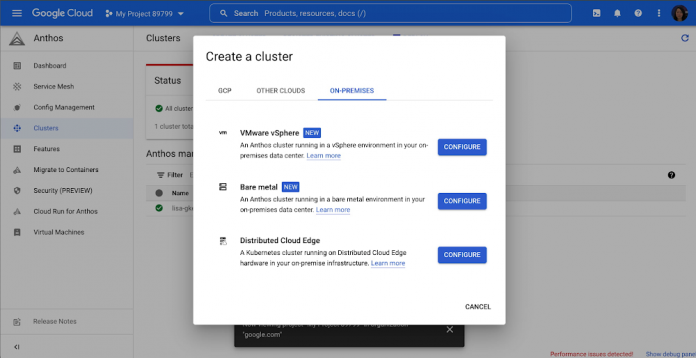Anthos is a cloud-centric container platform to run modern apps anywhere consistently at scale. Anthos manages your Kubernetes clusters not only on Google Cloud, but also in on-premises data centers and edges, as well as in other public clouds such as AWS and Azure. Anthos meets you where you are and helps you modernize applications in place.
Last year, we introduced a cloud-hosted multicloud API for performing lifecycle management of Anthos clusters on AWS and Azure. This year, we’re focused on bringing a consistent experience across hybrid, multicloud and Google Cloud environments, and are pleased to announce that a similar cloud-backed API concept is now available for your on-prem environments, enabling on-prem user cluster lifecycle management from the Google Cloud console. As a result, you can now create user clusters easily following simple on-screen steps, in addition to using the existing CLI process. You also can view cluster status details and perform cluster updates from the web user interface across Anthos cluster environments, including bare metal, VMware,AWSand Azure.
Setting up an Anthos user cluster on VMware
Now let’s take a look at an example of how to set up an Anthos user cluster on VMware (available in 1.11.1 release and later) with just a few steps.
First, select the “Create a cluster” option in the Anthos Clusters dashboard, and then choose the “VMware vSphere” environment type.
Then, choose an existing admin cluster from the drop-down menu, and configure the networking, storage and nodepool details you want for your new user cluster. This new experience assumes you already have a configured admin cluster in place. Once you fill in the required information, you can create the user cluster. You can see the cluster status details while it is being created and act upon failures as necessary.
Once the cluster is created, you can connect to it and deploy your applications. Existing user clusters created via the gkectl CLIs can be enrolled with the new cloud-hosted API and displayed in the console as well.
Performing Day 2 operations
Once you’ve created the user cluster, you can perform cluster Day 2 operations on it from the console. For example, you can easily upgrade the cluster version or update the node size of the user cluster control plane and memory.
For the Anthos clusters on bare metal deployment option, follow similar steps to set up a user cluster (see Figure 4). The feature is available in public Preview starting with the Anthos 1.13.0 release.
Managing Anthos clusters on AWS and Azure
For Anthos multicloud deployment options, we began supporting cluster lifecycle management via the gcloud CLI and Terraform late last year, and with this release, it’s now easy for you to update, upgrade and delete user clusters in AWS and Azure via the console (public Preview as of the 1.13 release). Figure 5 illustrates how you can update multiple cluster fields at once in the console.
To learn more about the exciting new cluster lifecycle management features in the console, please see the technical documentation here for the different Anthos deployment options on VMware, bare metal, AWS and Azure.
You can also watch our youtube videos of how to set up the user cluster on VMwareand on bare metal. Also be sure to check out the latest Anthos multicloud updates in Google Cloud Next ‘22.
Additional resources
Follow our Anthos clusters onbare metal or on VMware installation guide and create Anthos clusters in your existing hardware infrastructure. Explore Anthos clusters on bare metal with the cloud console using Google Compute Engine VMs.Check out the exciting announcements and sessions from Google Cloud NEXT 2022
Cloud BlogRead More


